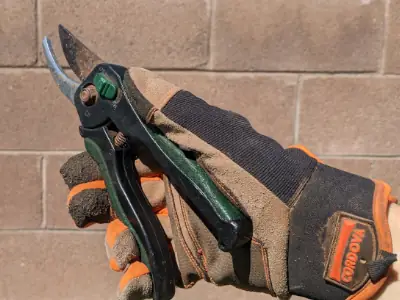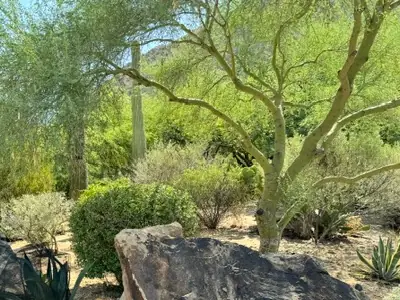If you’re a homeowner in Arizona you likely have trees, but supporting trees is not easy task. Trimming, for example is a complicated art, requiring many factors to be considering.
This Arizona tree trimming guide helps with balancing general principles with specific approaches for common Arizona tree species. By understanding why and how to trim trees you can help your Arizona trees survive in the brutal desert summers.
What's The Difference Between Trimming and Pruning?
While tree trimming and pruning are often used interchangeably, they have subtle differences in the arboriculture world.
Trimming typically refers to the removal of overgrown branches to maintain a tree’s shape or size, often for aesthetic purposes.
Pruning, on the other hand, is generally more selective and focuses on removing specific branches to improve the tree’s health, structure, or fruit production.
In practice, these terms overlap significantly, especially in urban forestry contexts like Arizona’s suburbs. For the purposes of this article, we’ll use both terms to encompass the broader practice of intentional branch removal for tree care.
Table of Contents
Best Methods for Trimming Tree Branches

For Arizona tree trimming, doing do so strategically is crucial. Removing dead, damaged, and diseased branches year-round is the best practice for promoting tree health and safety. When cutting live branches, trim just outside the branch collar to preserve the tree’s natural healing ability. Avoid both leaving stubs or cutting flush against the trunk.
Trimming Large Branches
For larger branches, use the three-cut method to prevent bark tearing: undercut partially, top cut slightly further out, then remove the remaining stub. This technique is vital in an arid climate such as the Arizona area where bark damage can lead to rapid desiccation (dehydration).
What to Consider when Arizona Tree Trimming
What Not to Trim
When you’re Arizona tree trimming, make sure not to remove too much material, especially at once. Maintain a strong leader (central trunk) for most species to help withstand intense heat and monsoon winds. Thin the canopy selectively to increase light and air circulation, but never remove more than 25% of live branches in one season to prevent sun damage to newly exposed bark.
Remember, each cut is a wound. In Arizona’s year-round growing season, trees can heal well, but trim purposefully and minimally. Always balance the tree’s health, safety, and aesthetics with the unique demands of our desert urban environment.
Timing Considerations
In Arizona’s extreme climate, timing is important. The scorching summer heat can stress trees, making them more susceptible to damage from trimming. Generally, late winter to early spring is ideal for most species, as it precedes the vigorous growth period. However, this principle isn’t universal.
Some desert-adapted trees may benefit from light pruning in early fall, preparing them for the cooler months when they experience a secondary growth spurt.
Water Conservation Techniques
Water is a precious resource in Arizona, and proper trimming plays a crucial role in conservation. By selectively removing branches, we can reduce a tree’s overall water demand. This doesn’t mean aggressive pruning; rather, it’s about creating a balanced canopy that maximizes shade while minimizing unnecessary foliage. Consider the tree’s natural shape and growth pattern, trimming to enhance these characteristics while reducing water usage.
Sun Exposure Management
Arizona’s intense sunlight can be both a blessing and a curse for trees. Proper Arizona tree trimming helps manage sun exposure, preventing sunscald on newly exposed bark. When removing branches, consider how it will affect the overall canopy structure. Aim to maintain a balanced shade pattern that protects the trunk and main branches while allowing sufficient light penetration to lower limbs and understory plants.
Pest and Disease Prevention

Arizona tree trimming is a powerful tool in the fight against pests and diseases that thrive in Arizona’s warm climate. Regular removal of dead, diseased, or infested branches can prevent issues from spreading. However, timing is crucial; avoid trimming during pest active seasons such as spring, as fresh cuts can attract harmful insects. Pests are usually least active in late fall and winter. Additionally, always sanitize tools between trees to prevent the spread of pathogens.
Aesthetic Considerations
The visual appeal of most trees is a major component of their value to homeowners. Trimming should enhance a tree’s natural form rather than force an unnatural shape. This approach not only looks better but also reduces stress on the tree. Consider the tree’s role in the broader landscape – as a shade provider, privacy screen, or focal point – and trim accordingly.
Safety Precautions
Safety is a critical aspect of Arizona tree trimming, especially in our urban environment. Regular trimming helps identify and remove potential hazards, such as weak branch unions or deadwood that could fall during monsoon storms. However, trimming itself can be dangerous, particularly for large trees. It’s often best to consult with certified arborists who understand both the biology of trees and the unique challenges posed by Arizona’s climate.
Special Considerations for Trees
Palo Verdes
 The Palo Verde, Arizona’s state tree, requires a unique approach to trimming. Its photosynthetic bark and distinctive branch structure demand careful consideration. Focus on maintaining the tree’s natural, open form while removing crossing or rubbing branches to prevent bark damage.
The Palo Verde, Arizona’s state tree, requires a unique approach to trimming. Its photosynthetic bark and distinctive branch structure demand careful consideration. Focus on maintaining the tree’s natural, open form while removing crossing or rubbing branches to prevent bark damage.
Timing is crucial for Palo Verde trimming. Prune in late winter or early spring, before the spring growth flush. This minimizes stress and allows the tree to quickly heal wounds. Be cautious not to over-trim, as the Palo Verde’s green bark is susceptible to sunscald. Maintain a balance between thinning for air circulation and preserving enough canopy to protect the trunk and main branches from intense Arizona sun.
Blue Palo Verdes
Blue Palo Verdes require extra care due to their distinctive blue-green bark, which is highly susceptible to sunscald. When trimming, focus on showcasing this unique coloration while maintaining sun protection. As accent trees in Arizona’s landscape, prune to enhance their striking appearance while complementing surrounding vegetation.
Mesquites
 Mesquite trees, including the common velvet mesquite, are known for their aggressive growth and require regular attention in Arizona’s urban landscape. Focus on controlling the tree’s spread while preserving its natural, gnarled character. Remove low-hanging branches to improve clearance and thin the canopy to reduce wind resistance, particularly important during monsoon seasons.
Mesquite trees, including the common velvet mesquite, are known for their aggressive growth and require regular attention in Arizona’s urban landscape. Focus on controlling the tree’s spread while preserving its natural, gnarled character. Remove low-hanging branches to improve clearance and thin the canopy to reduce wind resistance, particularly important during monsoon seasons.
Trim mesquites in late winter to early spring, before new growth emerges. This timing allows for better wound healing and reduces the risk of pest infestation. When trimming, prioritize the removal of crossing branches and those growing towards the center of the tree. Be mindful of the balance between providing shade and conserving water – a properly trimmed mesquite can be both drought-tolerant and an effective shade provider.
Velvet Mesquites
For velvet mesquites, be extra cautious of the thorny growth. Wear protective gear and dispose of trimmings carefully. These trees play a vital role in wildlife habitats, so balance urban landscaping needs with ecological considerations. Maintain a full, spreading canopy for shade while ensuring it doesn’t interfere with structures or utilities. Regular maintenance is key to managing mesquites’ vigorous growth in Arizona’s urban settings.
Desert Willows
The Desert Willow, with its graceful form and beautiful flowers, requires a light touch when trimming. The goal is to enhance its natural shape while encouraging abundant blooming. Focus on removing dead, damaged, or crossing branches, and lightly thin the canopy to improve air circulation.
Timing is flexible for Desert Willows, but late winter is ideal for major pruning. During the growing season, deadhead spent blooms to promote continued flowering. Be cautious not to over-trim, as this can reduce blooming. Instead, selectively remove older branches to stimulate new growth. In Arizona’s urban settings, you may need to manage the tree’s spread and height, but always maintain the flowing, fountain-like shape that makes Desert Willows so appealing.
The Arizona Cypresses
 The Arizona Cypress, with its conical form and dense foliage, requires minimal pruning. The focus should be on maintaining its natural shape while ensuring it remains healthy and wind-resistant. Remove dead or diseased branches as they appear, and thin the interior slightly to improve air circulation, which is crucial in Arizona’s hot, dry climate.
The Arizona Cypress, with its conical form and dense foliage, requires minimal pruning. The focus should be on maintaining its natural shape while ensuring it remains healthy and wind-resistant. Remove dead or diseased branches as they appear, and thin the interior slightly to improve air circulation, which is crucial in Arizona’s hot, dry climate.
Timing for Arizona Cypress trimming is flexible, but avoid pruning in late summer or fall to prevent stimulating new growth that could be damaged by winter cold. When shaping, preserve the tree’s natural conical form – avoid flat-topping or shearing, which can damage the tree’s structure and aesthetics. In urban Arizona settings, you may need to remove lower branches for clearance, but maintain at least two-thirds of the tree’s height in living branches to ensure vigor and stability.
Ironwoods
The Ironwood, a slow-growing desert native, requires minimal and thoughtful trimming. Its cultural significance and role in the Sonoran Desert ecosystem should guide pruning decisions. Focus on removing dead or crossing branches, and only lightly shape if necessary to fit urban spaces.
Trim Ironwoods in late winter or early spring, before new growth begins. Be extremely conservative in your approach – Ironwoods can take decades to reach maturity, and each cut represents a significant investment of the tree’s energy. In Arizona’s urban landscape, you may need to raise the canopy for clearance, but preserve the tree’s natural multi-trunked form.
Arizona Sycamores
The Arizona Sycamore, a riparian species adapted to urban Arizona, requires specific trimming strategies. Focus on maintaining its natural, spreading form while managing its size for urban spaces. Regular pruning is necessary to control its vigorous growth and maintain a strong structure.
Trim Arizona Sycamores in late winter when the tree is dormant. This reduces sap flow and makes it easier to see the tree’s structure. Remove crossing or rubbing branches and thin the canopy to improve air circulation, crucial in Arizona’s hot climate. Be prepared for significant leaf litter – proper trimming can help manage this by removing excessive small branches. In urban settings, you may need to raise the canopy for clearance, but maintain the tree’s natural, majestic form that makes it a standout in Arizona landscapes.
By understanding the general principles and species-specific needs, you can nurture our urban forest to thrive in this challenging environment. Through thoughtful, informed trimming practices, you can ensure your trees will last from generation to generation.
Alliance Manpower's Tree Services
Alliance Manpower can meet all your tree care needs with our comprehensive service. Check out our Arizona tree care pages for more information:
Arizona Tree Care From Alliance Manpower



